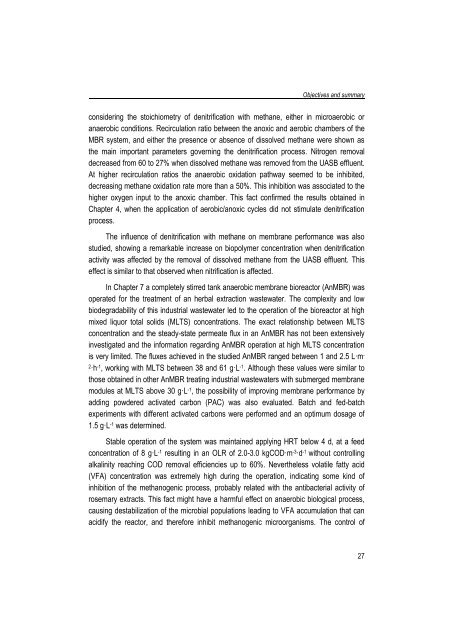Combining submerged membrane technology with anaerobic and ...
Combining submerged membrane technology with anaerobic and ...
Combining submerged membrane technology with anaerobic and ...
You also want an ePaper? Increase the reach of your titles
YUMPU automatically turns print PDFs into web optimized ePapers that Google loves.
Objectives <strong>and</strong> summaryconsidering the stoichiometry of denitrification <strong>with</strong> methane, either in microaerobic or<strong>anaerobic</strong> conditions. Recirculation ratio between the anoxic <strong>and</strong> aerobic chambers of theMBR system, <strong>and</strong> either the presence or absence of dissolved methane were shown asthe main important parameters governing the denitrification process. Nitrogen removaldecreased from 60 to 27% when dissolved methane was removed from the UASB effluent.At higher recirculation ratios the <strong>anaerobic</strong> oxidation pathway seemed to be inhibited,decreasing methane oxidation rate more than a 50%. This inhibition was associated to thehigher oxygen input to the anoxic chamber. This fact confirmed the results obtained inChapter 4, when the application of aerobic/anoxic cycles did not stimulate denitrificationprocess.The influence of denitrification <strong>with</strong> methane on <strong>membrane</strong> performance was alsostudied, showing a remarkable increase on biopolymer concentration when denitrificationactivity was affected by the removal of dissolved methane from the UASB effluent. Thiseffect is similar to that observed when nitrification is affected.In Chapter 7 a completely stirred tank <strong>anaerobic</strong> <strong>membrane</strong> bioreactor (AnMBR) wasoperated for the treatment of an herbal extraction wastewater. The complexity <strong>and</strong> lowbiodegradability of this industrial wastewater led to the operation of the bioreactor at highmixed liquor total solids (MLTS) concentrations. The exact relationship between MLTSconcentration <strong>and</strong> the steady-state permeate flux in an AnMBR has not been extensivelyinvestigated <strong>and</strong> the information regarding AnMBR operation at high MLTS concentrationis very limited. The fluxes achieved in the studied AnMBR ranged between 1 <strong>and</strong> 2.5 L·m -2·h -1 , working <strong>with</strong> MLTS between 38 <strong>and</strong> 61 g·L -1 . Although these values were similar tothose obtained in other AnMBR treating industrial wastewaters <strong>with</strong> <strong>submerged</strong> <strong>membrane</strong>modules at MLTS above 30 g·L -1 , the possibility of improving <strong>membrane</strong> performance byadding powdered activated carbon (PAC) was also evaluated. Batch <strong>and</strong> fed-batchexperiments <strong>with</strong> different activated carbons were performed <strong>and</strong> an optimum dosage of1.5 g·L -1 was determined.Stable operation of the system was maintained applying HRT below 4 d, at a feedconcentration of 8 g·L -1 resulting in an OLR of 2.0-3.0 kgCOD·m -3·d -1 <strong>with</strong>out controllingalkalinity reaching COD removal efficiencies up to 60%. Nevertheless volatile fatty acid(VFA) concentration was extremely high during the operation, indicating some kind ofinhibition of the methanogenic process, probably related <strong>with</strong> the antibacterial activity ofrosemary extracts. This fact might have a harmful effect on <strong>anaerobic</strong> biological process,causing destabilization of the microbial populations leading to VFA accumulation that canacidify the reactor, <strong>and</strong> therefore inhibit methanogenic microorganisms. The control of27
















